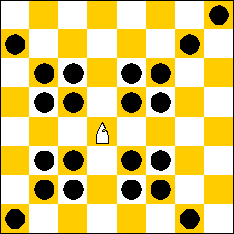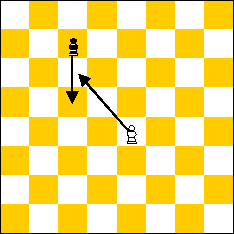Hammer Chess
(c) 1998 Jim Aikin
The impetus for Hammer Chess arose from how hard it is to find opponents to play any type of chess variant. I figured, if a variant uses the standard board and standard pieces, it's bound to be easier to play than if it requires extra equipment. Remembering that chess got a tremendous boost a few hundred years ago when the moves of the queen and bishop were enhanced, I thought a good variant might be created by enhancing the moves of some of the existing pieces a bit further.Rules
All of the standard rules of FIDE chess apply in Hammer Chess, with the following exceptions:(1) The knight can move either as a chess knight or in an L shape that is one square longer. This diagram shows the possible destination squares for a knight on an open board:



Strategic considerations
Although Hammer Chess has yet to be played, we can make a couple of educated guesses about how games will develop. Pawn structures will be more open and flexible, and their power will reach deeper into enemy territory. The pawn's two-square capture means that a white pawn on e4 is directly protected by the pawns on c2 and g2, and can capture black's queen's knight if the knight is developed at c6. Because each player's pawns initially control the player's 3rd and 4th ranks, attacking moves across the center line will be harder to make until a hole has been punched in the opponent's pawn position. Pawns stationed on the 3rd and 4th ranks will make the enemy's piece development more difficult. On the other hand, a knight on the 4th rank directly threatens enemy pawns on their starting squares. The bishops can be developed without moving a pawn out of the way, and can be maneuvered more flexibly in response to an attack.The enhancement of the weaker pieces means that the distinction between "minor" and "major" pieces has to be reevaluated. To look at it another way, the value of the queen and rook is comparatively less than in standard chess. At a guess, if we rate the Hammer Chess pawn's value as 1, the queen and bishop may be worth about 7 each, the knight 3 and the rook 4, making the knight and rook the minor pieces. Even so, they're probably too valuable to be used in a reckless sacrifice of a knight for two pawns, for example. Attack in Hammer Chess may prove to be more difficult, and defense easier, at least in the opening. The greater maneuverability of the pieces will be compromised by the fact that the board will feel more crowded, with more threats massed on each square.
Written by Jim Aikin. Email Jim if you want to play this game against him. Diagrams drawn and very minor editing by Hans Bodlaender.
WWW page created: January 5, 1998.